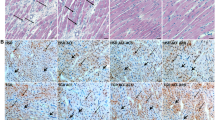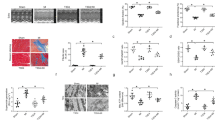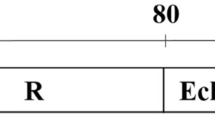Abstract
Oxidative stress is implicated in the pathogenesis of various cardiovascular diseases. We have shown that in Wistar rats with a suprarenal aortic constriction (AC), pressure overload–induced transient perivascular inflammation (monocyte chemoattractant protein-1 [MCP-1] induction and macrophage accumulation) in the early phase is the determinant of reactive myocardial fibrosis and resultant diastolic dysfunction in the late phase. Thus, we investigated the role of reactive oxygen species production in cardiac remodeling in AC rats. Superoxide production and the footprint of lipid peroxidation were assessed using dihydroethidium staining and immunohistostaining against 4-hydroxy-2-nonenal (4-HNE), respectively. In sham rats, dihydroethidium and 4-HNE signals were scarcely found in the heart. At day 3, AC rats showed dihydroethidium signals mainly in the intramyocardial arterial wall, whereas modest 4-HNE staining was observed diffusely in the myocardium. These signals declined to lower levels by day 14 despite sustained hypertension. Chronic administration of a subdepressor dose of an angiotensin II type 1 receptor blocker candesartan reduced the pressure overload–induced dihydroethidium and 4-HNE signals at day 3. Moreover, candesartan decreased MCP-1 induction and macrophage infiltration at day 3 and prevented myocardial fibrosis at day 14, without affecting left ventricle and myocyte hypertrophy. In conclusion, acute pressure overload induced self-limited superoxide production mainly in the vascular wall. The reactive oxygen species production would contribute to the perivascular inflammation and subsequent myocardial fibrosis. Angiotensin II was suggested to have a pressure-independent effect on the reactive oxygen species production.
Similar content being viewed by others
Article PDF
References
Brilla CG, Weber KT : Reactive and reparative myocardial fibrosis in arterial hypertension in the rats. Cardiovasc Res 1992; 26: 671–677.
Kuwahara F, Kai H, Tokuda K, et al: Transforming growth factor-β function blocking prevents myocardial fibrosis and diastolic dysfunction in pressure-overloaded rats. Circulation 2002; 106: 130–135.
Kuwahara F, Kai H, Tokuda K, et al: Roles of intercellular adhesion molecule-1 in hypertensive cardiac remodeling. Hypertension 2003; 41: 819–823.
Kuwahara F, Kai H, Tokuda K, et al: Hypertensive myocardial fibrosis and diastolic dysfunction—another model of inflammation—. Hypertension 2004; 43: 739–745.
Kai H, Kuwahara F, Tokuda K, Imaizumi T : Diastolic dysfunction in hypertensive hearts: roles of perivascular inflammation and reactive myocardial fibrosis. Hypertens Res 2005; 28: 483–490.
Tokuda K, Kai H, Kuwahara F, et al: Pressure-independent effects of angiotensin II on hypertensive myocardial fibrosis. Hypertension 2004; 43: 499–503.
Lassegue B, Griendling KK : Reactive oxygen species in hypertension; an update. Am J Hypertens 2004; 17: 852–860.
Taniyama Y, Griendling KK : Reactive oxygen species in the vasculature: molecular and cellular mechanisms. Hypertension 2003; 42: 1075–1081.
Griendling KK, FitzGerald GA : Oxidative stress and cardiovascular injury. Part I: basic mechanisms and in vivo monitoring of ROS. Circulation 2003; 108: 1912–1916.
Griendling KK, FitzGerald GA : Oxidative stress and cardiovascular injury. Part II: animal and human studies. Circulation 2003; 108: 2034–2040.
Beswick RA, Dorrance AM, Leite R, Webb RC : NADH/NADPH oxidase and enhanced superoxide production in the mineralocorticoid hypertensive rat. Hypertension 2001; 38: 1107–1111.
Rajagopalan S, Kurz S, Munzel T, et al: Angiotensin II–mediated hypertension in the rat increases vascular superoxide production via membrane NADH/NADPH oxidase activation. Contribution to alterations of vasomotor tone. J Clin Invest 1996; 97: 1916–1923.
Heitzer T, Wenzel U, Hink U, et al: Increased NAD(P)H oxidase–mediated superoxide production in renovascular hypertension: evidence for an involvement of protein kinase C. Kidney Int 1999; 55: 252–260.
Yao L, Kobori H, Rahman M, et al: Olmesartan improves endothelin-induced hypertension and oxidative stress in rats. Hypertens Res 2005; 27: 493–500.
Limas CJ : Increased number of β-adrenergic receptors in the hypertrophied myocardium. Biochim Biophys Acta 1979; 588: 174–178.
Kuwahara F, Kai H, Tokuda K, et al: Hypoxia-inducible factor-1α/vascular endothelial growth factor pathway for adventitial vasa vasorum formation in hypertensive rat aorta. Hypertension 2002; 39: 46–50.
Tokuda K, Kai H, Kuwahara F, Imaizumi T : Sub-depressor dose of angiotensin type-1 receptor blocker inhibits TGF-β−mediated perivascular fibrosis in hypertensive rat hearts. J Cardiovasc Pharmacol 2003; 42 ( Suppl): S61–S65.
Kai H, Muraishi A, Sugiu Y, et al: Expression of proto-oncogenes and gene mutation of sarcomeric proteins in patients with hypertrophic cardiomyopathy. Circ Res 1998; 83: 594–601.
Takemoto M, Egashira K, Tomita H, et al: Chronic angiotensin-converting enzyme inhibition and angiotensin II type 1 receptor blockade. Effects on cardiovascular remodeling in rats induced by the long-term blockade of nitric oxide synthesis. Hypertension 1997; 30: 1621–1627.
Takimoto E, Champion HC, Li M, et al: Oxidant stress from nitric oxide synthase-3 uncoupling stimulates cardiac pathologic remodeling from chronic pressure load. J Clin Invest 2005; 115: 1221–1231.
Griendling KK, Minieri CA, Ollerenshaw JD, Alexander RW : Angiotensin II stimulates NADH and NADPH oxidase activity in cultured vascular smooth msucle cells. Circ Res 1994; 74: 1141–1148.
Griendling KK, Ushio-Fukai M : Redox control of vascular smooth muscle proliferation. J Lab Clin Med 1998; 132: 9–15.
Sawyer DB, Siwik DA, Xiao L, Pimentel DR, Singh K, Colucci WS : Role of oxidative stress in myocardial hypertrophy and failure. J Mol Cell Cardiol 2002; 34: 379–388.
Chen XL, Tummala PE, Olbrych MT, Alexander RW, Medford RM : Angiotensin II induces monocyte chemoattractant protein-1 gene expression in rat vascular smooth muscle cells. Circ Res 1998; 83: 952–959.
Han Y, Runge MS, Brasier AR : Angiotensin II induces interleukin-6 transcription in vascular smooth muscle cells through pleiotropic activation of nuclear factor-kappa B transcription factors. Circ Res 1999; 84: 695–703.
Steinhauser ML, Kunkel SL, Hogaboam CM, Evanoff H, Strieter RM, Lukacs NW : Macrophage/fibroblast coculture induces macrophage inflammatory protein-1alpha production mediated by intercellular adhesion molecule-1 and oxygen radicals. J Leukoc Biol 1998; 64: 636–641.
Siwik DA, Tzortzis JD, Pimental DR, et al: Inhibition of copper-zinc superoxide dismutase induces cell growth, hypertrophic phenotype, and apoptosis in neonatal rat cardiac myocytes in vitro. Circ Res 1999; 85: 147–153.
Weber KT, Brilla CG : Pathological hypertrophy and cardiac interstitium. Fibrosis and renin-angiotensin-aldosterone system. Circulation 1991; 83: 1849–1865.
Pimentel DR, Amin JK, Xiao L, et al: Reactive oxygen species mediate amplitude-dependent hypertrophic and apoptotic responses to mechanical stretch in cardiac myocytes. Circ Res 2001; 89: 453–460.
Ide T, Tsutsui H, Kinugawa S, et al: Mitochondrial electron transport complex I is a potential source of oxygen free radicals in the failing myocardium. Circ Res 1999; 85: 357–363.
Gupta M, Singal PK : Higher antioxidative capacity during a chronic stable heart hypertrophy. Circ Res 1989; 64: 398–408.
Dhalla NS, Temsah RM, Netticadan T : Role of oxidative stress in cardiovascular diseases. J Hypertens 2000; 18: 655–673.
Tanaka M, Umemoto S, Kawahara S, et al: Angiotensin II type 1 receptor antagonist and angiotensin-converting enzyme inhibitor altered the activation of Cu/Zn-containing superoxide dismutase in the heart of stroke-prone spontaneously hypertensive rats. Hypertens Res 2005; 28: 67–77.
Author information
Authors and Affiliations
Corresponding author
Rights and permissions
About this article
Cite this article
Kai, H., Mori, T., Tokuda, K. et al. Pressure Overload–Induced Transient Oxidative Stress Mediates Perivascular Inflammation and Cardiac Fibrosis through Angiotensin II. Hypertens Res 29, 711–718 (2006). https://doi.org/10.1291/hypres.29.711
Received:
Accepted:
Issue date:
DOI: https://doi.org/10.1291/hypres.29.711
Keywords
This article is cited by
-
Targeted inhibition of Focal Adhesion Kinase Attenuates Cardiac Fibrosis and Preserves Heart Function in Adverse Cardiac Remodeling
Scientific Reports (2017)
-
Early urinary biomarkers for renal tubular damage in spontaneously hypertensive rats on a high salt intake
Hypertension Research (2016)
-
Membrane ERα attenuates myocardial fibrosis via RhoA/ROCK-mediated actin remodeling in ovariectomized female infarcted rats
Journal of Molecular Medicine (2014)
-
Role of STAT3 in angiotensin II-induced hypertension and cardiac remodeling revealed by mice lacking STAT3 serine 727 phosphorylation
Hypertension Research (2013)
-
The antifibrotic agent pirfenidone inhibits angiotensin II-induced cardiac hypertrophy in mice
Hypertension Research (2012)



